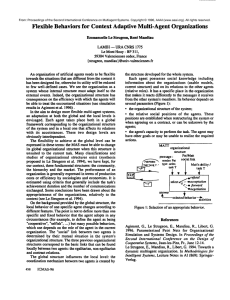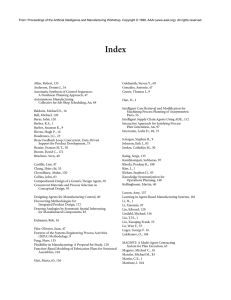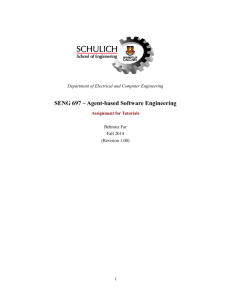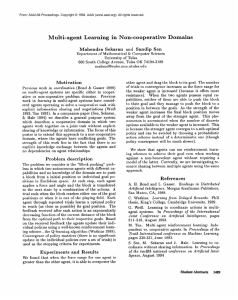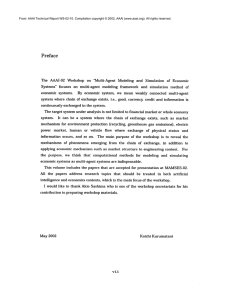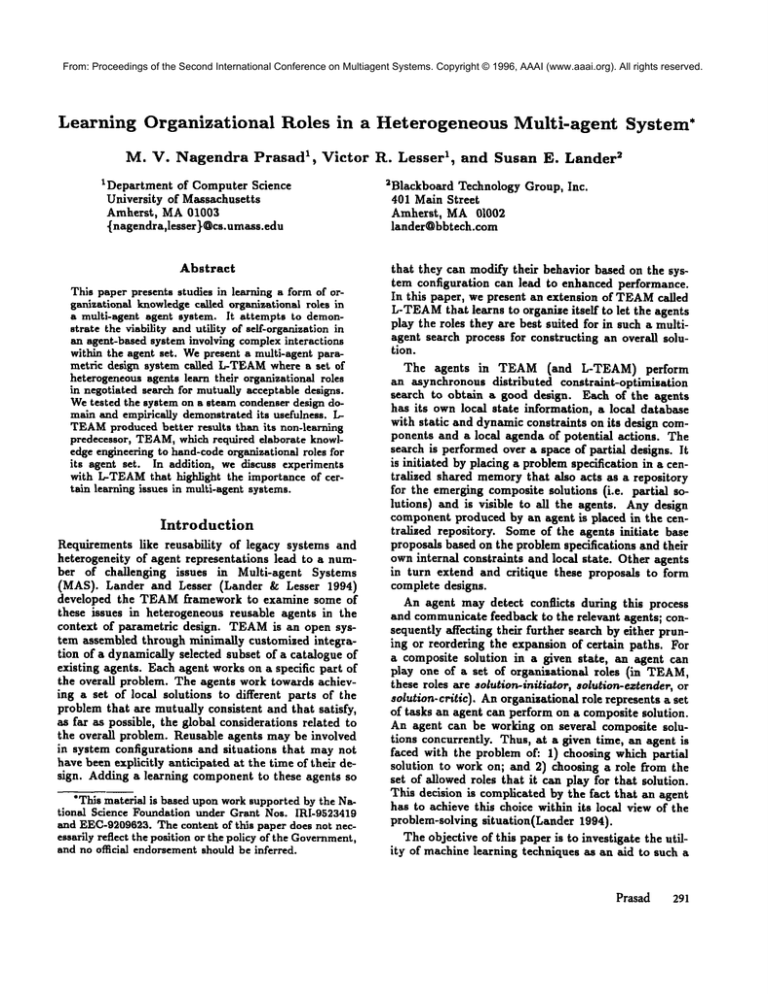
From: Proceedings of the Second International Conference on Multiagent Systems. Copyright © 1996, AAAI (www.aaai.org). All rights reserved.
Learning
Organizational
M. V.
Nagendra
Roles
Prasad
1,
in a Heterogeneous
Victor
1Department of Computer Science
University of Massachusetts
Amherst,
MA 01003
{nagendra,lesser
)@cs.umass.edu
Abstract
This paper presents studies in learning a form of organizational knowledge called organizational roles in
a multl-agent agent system. It attempts to demonstrate the viability and utility of self-organlzation in
an agent-based system involving complex interactions
within the agent set. We present a multi-agent parametric designsystemcalledL-TEAMwherea set of
heterogeneous
agentslearntheirorganizational
roles
in negotiated
searchfor mutually
acceptable
designs.
We testedthe systemon a steamcondenser
designdomainandempirically
demonstrated
itsusefulness.
LTEAMproducedbetterresultsthan its non-learning
predecessor,
TEAM,whichrequiredelaborate
knowledgeengineering
to hand-code
organizational
rolesfor
its agentset. In addition,
we discussexperiments
with L-TEAMthat highlight
the importance
of certainlearning issues in multi-agent systems.
Introduction
Requirements like reusability
of legacy systems and
heterogeneity of agent representations
lead to a number of challenging
issues in Multi-agent
Systems
(MAS). Lander and Lesser (Lander & Lesser 1994)
developed
the TEAM framework to examine some of
these issues in heterogeneous reusable agents in the
context of parametric
design. TEAMis an open system assembled through minimally customized integration of a dynamically selected subset of a catalogue of
existing agents. Each agent works on a specific part of
the overall problem. The agents work towards achieving a set of local solutions to different parts of the
problem that are mutually consistent and that satisfy,
as far as possible, the global considerations related to
the overall problem. Reusable agents may be involved
in system configurations
and situations
that may not
have been explicitly anticipated at the time of their design. Adding a learning component to these agents so
*This material is based upon work supported by the Nationed Science Foundation under Grant Nos. IRI-9523419
and EEC-9209623. The content of this paper does not necessarily reflect the position or the policy of the Government,
and no official endorsement should be inferred.
R.
Lesser
1,
2and
Multi-agent
Susan
2Blackboard Technology
401 Main Street
Amherst, MA 01002
lander@bbtech.com
E.
System*
Lander
Group, Inc.
that they can modifytheirbehaviorbasedon the system configuration
can lead to enhancedperformance.
In this paper,we presentan extensionof TEAM called
L-TEAMthatlearnsto organizeitselfto let the agents
playtherolestheyare bestsuitedfor in sucha multiagentsearchprocessfor constructing
an overallsolution.
The agents in TEAM (and L-TEAM) perform
an asynchronous
distributedconstralnt-optimization
search to obtain a good design. Each of the agents
has its own local state information, a local database
with static and dynamic constraints
on its design components and a local agenda of potential
actions. The
search is performed over a space of partial designs. It
is initiated by placing a problem specification in a centralized shared memory that also acts as a repository
for the emerging composite solutions (i.e. partial solutions) and is visible to all the agents. Any design
component produced by an agent is placed in the centralized repository.
Some of the agents initiate
base
proposals based on the problem specifications
and their
own internal constraints
and local state. Other agents
in turn extend and critique
these proposals to form
complete designs.
An agent may detect conflicts
during this process
and communicate feedback to the relevant agents; consequently affecting their further search by either pruning or reordering the expansion of certain paths. For
a composite solution in a given state,
an agent can
play one of a set of organizational
roles (in TEAM,
these roles are solution-initiator,
solu~ion-eztender, or
solution-critic).
An organizational role represents a set
of tasks an agent can perform on a composite solution.
An agent can be working on several composite solutions concurrently. Thus, at a given time, an agent is
faced with the problem of: 1) choosing which partial
solution to work on; and 2) choosing a role from the
set of allowed roles that it can play for that solution.
This decision is complicated by the fact that an agent
has to achieve this choice within its local view of the
problem-solving situation(Lander
1994).
The objective of this paper is to investigate the utility of machinelearningtechniques
as an aid to such a
Prasad
291
From: Proceedings of the Second International Conference on Multiagent Systems. Copyright © 1996, AAAI (www.aaai.org). All rights reserved.
decision process in situations where the set of agents
involved in problem solving are not necessarily known
to the designer of any single agent. The results demonstrate the utility and viability oflearning such decisions
in complex, heterogeneous multi-agent systems, and
then go on to provide empirical support for two important observations regarding learning in multi-agent
systems:
1. A credit assignment scheme can lead to enhanced
learning if it considers the relations between an action and the progress of the overall problem-solving
process, in addition to the end result that the action
may lead to.
2. "lYeatin 8 problem solving control as situationspecific can be beneficial(discussed in detail in Section ).
The rest of the paper is organized as follows. Section
discusses the characteristics of organizational roles in
distributed search and Section presents our use of
the UPCformalism(Whitehair & Lesser 1993) as a basis for learning organizational knowledgeand discusses
our learning setup. The following section discusses an
implementation of L-TEAMbased on this algorithm
and presents the results of our empirical explorations.
Weconclude by discussing some related work and the
implications of this work.
Organizational
Roles in Distributed
Search
Organizational knowledge can be described as a specification of the way the overall search should be organized in terms of which agents play what roles in
the search process and communicatewhat information,
when and to whom. It provides the agents a way to
effectively and reliably handle cooperative tasks. Organizational roles represent a form of organization knowledge that lets each agent in L-TEAM
take part in the
formation of a composite solution in a certain capacity. An organizational role is a task or a set of tasks
to be performed in the context of a single solution. A
role may encompass one or more operators, e.g., the
role solution-initiator includes the operators initiatesolution and eelaz-solution-requirement. A pattern of
activation of roles in an agent set is a role assignment.
All agents need not play all organizational roles. Organizational roles played by the agents are important
for the efficiency of a search process and the quality of
final solutions produced.
To illustrate the above issue, we will use a simple,
generic two-agent example. Figure I shows their search
and solution spaces. The shaded portions in the local
spaces of the agents A and B are the local solution
spaces and their intersection represents the global solution space. It is dear that if agent A initiates and
agent B extends, there is a greater chance of finding
a mutually acceptable solution. Agent A trying to extend a solution initiated by Agent ]3 is likely to lead
292
ICMAS-96
to a failure more often than not due the small intersection space versus the large local solution space in
Agent B. Note however, that the solution distribution
in the space is not knowna priori to the designer to
hand code good organizational roles at the design time.
This paper investigates the effectiveness of learning
situation-specific organizational role assignments. No
single organizational role assignment may be good for
all situations. The agents adapt themselves to play
roles that are better suited for the current problem
solving situation, so as to be effective (we will discuss
situations in more detail in the following section).
Learning
Role Assignments
Learning involves exploring the space of role assignments, developing rating measures for roles in various
situations. The formal basis for learning role assignments is derived from the UPCformalism for search
control (see Whitehair and Lesser(Whitehair & Lesser
1993)) that relies on the calculation and use of the
Utility, Probability and Cost (UPC) values associated
with each ~state, R, final_state) tuple. Utility represents an agent’s estimate of the final state’s expected
value or utility if it takes on role R in the present state.
Probability represents the expected uncertainty associated with the ability to reach the final state from the
present state, given that the agent plays role R. Cost
represents the expected computational cost of reaching
the final state. These values comprise an explicit representation of the position of a search state with respect
to the potential final states in a search space. Additionally, in complex search spaces, a role that looks
like a poor choice from the perspective of a local control policy may actuary be a good choice from a more
global perspective due to some increased information
it makes available to the problem solver. This property
of a role is referred to as its potential and it needsto be
taken into account while rating the role. An evaluation
function defines the objective strategy of the problem
solving system based on the UPCcomponents of a role
and its potential. An agent applies the evaluation function to all the roles applicable at the present state of
the on-going search and selects the role that maximizes
the ratings.
Starting from this core of the UPCformalism, we
modifyit to suit our purpose of learning organizational
roles in negotiated search in multi-agent systems. Our
first modification involves classification of all possible
states of a search into pre-ennmeratedfinite classes of
situations. These classes of situations represent abstractions of the state of a search. Thus, for each agent,
there is UPCvector per situation per role leading to
a final state. A situation in L-TEAM
is represented
by a feature vector whose values determine the class
of a state of the search. Note that in order to get the
values of a situation vector at an agent, it might have
to communicatewith other agents to obtain the relevant information regarding features that relate to their
From: Proceedings of the Second International Conference on Multiagent Systems. Copyright © 1996, AAAI (www.aaai.org). All rights reserved.
$
It
m
Agent A
Agent B
SolutionSpacesol’AgenlsAandB L~verXandY
Composite
SolutionSpaccof A andB
Figure 1: Local and CompositeSearch Spaces
internal state. In L-TEAM,an agent choosing a role
indexes into a database of UPCvalues using the situation vector to obtain the relevant UPCvalues for the
roles applicable in the current state.
Weuse the supervised-learning approach to prediction learning (see (Sutton 1988)) to learn estimates
for the UPCvectors for each of the situations.
The
agents collectively explore the space of possible role
assignments to identify good role assignments in each
of the situations. The role assignment at a particulax agent is affected by the state of problem solving at
the other agents and also the nature of the non-local
search spaces. At each agent, the corresponding situation vector of the features representing the relevant
problem-solving activities at that time and an agent’s
choice of the role it plays are stored by that agent.
The performance measures arising out of this decision
will not be known at that time and become available
only at the completion of the search. After a sequence
of such steps leading to completion, the performance
measures for the entire problem solving process are
available. The agents then back trace through these
steps assigning credit for the performance to the roles
1.
involved (the exact process will be described below)
At each agent, values of the UPCvector for the role
corresponding to the situation at that agent are adjusted. In our use of the UPCframework, we assume
that there is a single final state -- the generation of a
complete design, mutually acceptable to all the agents.
Let { S~}, 1 _< j _< Mh,be the set of possible situation
vectors for Agentk where each situation vector is a permutation of the possible values for the situation-vector
features and let R~, 1 < i < Ark, be the set of roles an
Agent k can play in a composite solution. Agent k has
Mk * Nt vectors of UPCand Potential (abbreviated
as Po~) values:{
R~,S~,Agentk, U~,P~, C~j, Pot,~j }.
Given a situation S~, objective function f(U, P, C, Po~)
is used to select a role R~ such that
1In this paper we are primarily concerned with showing
the benefits and characteristics of learning in multi-agent
systemsrather than with the merits of a particular learning
method over others. The reason for choosing supervised
learning methodis simply that it workedfor us.
s. is Is
l ( rJ’.,.P’-~
,C.b,Pot
.,Is
E,.tul
J~ sibt".Is ~btcIs
~b w-~
o-tIs,
ill
During |earniTtg
R.h
--’fa I max/f(U~, P~,
CJs,’Potlb)
After learning
where 1 < i < N, and kf~X(rating) represents the
role whose UPCvalues are such that f(U, P, C, Pot)
rating.
There axe various ways of doing the actual changes
to the UPCand Potential values of each situation vector and we discuss some simple schemes here. Let
U~ represent the predicted utility of the final soution achieved by Agent k playing role Ri in a state n
that can be classified as situation j, accumulated after
p problem solving instances. Let ~’(7") be the set
states on the path to a final state F. UFrepresents the
utility of the solution and 0 < ¢~ <_ 1 is the learning
rate.
Prob(R~)
tp)
: + (u,, - c, u,9, n
where stere n 6 airier/on
j. Thus Agent k that
played role P~, modifies the Utility for its R~in situation j.
Let (p)P~. represent Agent k’s estimated probability
that playing role//4 in a state n that can be classified as
situation j will lead to a final state, accumulatedafter
p problem solving instances. Let J:(T) be the set
states on the path to a terminal state T. OTE {0, 1} is
the output of the terminal state T with 1 representing
success and 0 a failure. O < cr < 1 is the learning rate.
where state n 6 sfluation j
Wewill not dwell on the details of the Cost component update rule because the evaluation functions used
in this work do not involve cost. In a design problem
solving system, the computational costs are not a primary consideration. Successfully completing a good
design takes precedence over computational costs involved as long as the costs are not widely disparate.
Obtaining measures of potential is a more involved
process and requires a certain understanding of the system - at least to the extent of knowing which are the
Pra~d
29~
From: Proceedings of the Second International Conference on Multiagent Systems.
Copyright
© 1996, AAAI
reserved.
system
terminates
upon(www.aaai.org).
formation ofAllarights
mutually
ac-
activities that can potential]y make positive or negative contribution to progress of the problem solving
process. For example, in L-TEAM,
earlier on in a problem solving episode, the agents take on roles that lead
to infeasible solutions due to conflicts in their requirements. However,this process of running into a conflict
leads to certain important consequences like exchange
of constraints that were violated. The constraints an
agent receives from other agents aid that agent’s subsequent search in that episode by letting it relate its local solution requirements to more global requirements.
Hence, the roles leading to conflicts followed by information exchange are rewarded by potential. Learning
algorithms similar to that for utility can be used for
learning ¯the potential¯ of a role¯ Let¯ (p)Pot~J represent
.
the predicted potential of the terminal state achieved
by Agent k playing role /h in a state n which can be
classified as situation j, accumulated after p problem
solving instances. Let ~’(T) be the set of states
the path to the terminal state T, Port E ~0, l~ be the
potential arising from the state T, where POrT= 1 if
there is is a conflict followed by information exchange
else Port ---- O. Let 0 <_ a _< 1 be the learning rate.
where state n E situation
j
Experimental
Results
To demonstrate the effectiveness of the mechanisms
in L-TEAMand compare them to those in TEAM,
we used the same domain as in Lander(Lander 1994)
-- parametric design of steam condensers.
The
prototype multi-agent system for this domain, built
on top of the TEAMframework, consists of seven
agents: pump-agent, heat-exchanger-agent,
motoragent, vbelt-agent, shaft-agent, platform-agent, and
frequency-critic. The problem solving process starts by
placing a problem specification on a central blackboard
(BB). Problem specification consists of three parameters -- required capacity, platform side length, and
maximumplatform deflection. During each cycle, each
of the agents in L-TEAM
can decide either to initiate
a design based on the problem specification or ez~end
a partial design on the BBor to critique a partial design on the BB. During the process of extending or
critiquing a design, an agent can detect conflicts and
communicatethe cause of the conflict to other agents
if it can articulate it. At present, an agent can communicate only single-clause numeric boundary constraints
that are violated. If the receiving agent can understand
the feedback (i.e. the parameter of the communicated
constraint is in its vocabulary), it assimilates the information and uses it to constrain future searches. If
such conflict avoidance search does not work, an agent
tries conflict resolution by resorting to relazing soft
constraints. In addition, if an agent detects stagnation
in the progress of the local problem solving process, it
relaxes the local quaiity requirement thresholds. The
294
ICMAS-96
ceptable design that satisfies the local quality thresholds of all the agents.
Each agent has an assigned organizational role in any
single design. As mentioned before, TEAM
identifies ,
three organisationai roles -- initiate-design, extenddesign, and critique-design. Learning the appropriate
application of all these roles can be achieved, but in
this paper we confine ourselves to two roles in each
agent - initiate-design
and extend-design. Four of
the seven agents -- pump-agent, motor-agent, heatexchanger-agent, and vbelt-agent ---are learning either
to initiate a design or to extend an existing partial design in each situation. The other three agents have
fixed organizational roles -- platform and shaft agents
always extend and frequency-critic always critiques.
In the experiments reported below, the situation vector for each agent had three components. The first
component represented changes in the global views of
any of the agents in the system. If any of the agents receives any new external constraints from other agents
in the past m time units (m was 4 in the experiments.),
this componentis ’1’ for all agents. Otherwiseit is ’O’.
If any of the agents has relaxed its local quality requirements in the past n time units (n = 2) then the
second component is ’1’ for all agents. Otherwise it
is ’0’. Receiving a new external constraint or relaxing
local quality requirements change the nature of the local search space of an agent. This could prompt it
to initiate designs to seed the blackboard with partial designs that take these constraints into consideration. Typically, a problem solving episode in L-TEAM
starts with an initial phase of generating seed designs,
followed by a phase of exchange of all the communicable information involved in conflicts and then a phase
where the search is more informed and all the information that leads to conflicts and can be communicated
has already been exchanged. During the initial phase,
the third component is ’1’. During the intermediate
phase of conflict detection and exchange of information, the third component is ’2’. In the final phase,
it is ’3’. During the initial phase, some agents may
often play the role of initiators of designs so as lead
to discovery of conflicting requirements that can be
exchanged during the intermediate phase to enhance
each of the agents’ view of the global requirements on
its local search. It is important to note that these features are based on the negotiated search mechanisms
rather than the underlying steam condenser domain.
They are generic to the domain of parametric design
2.
that TEAMaddresses
In design problemsolving, the probability of successfully completing a design and obtaining a high utility
design are of primary considerations. In addition, in
a complex open environment llke that in the L-TEAM
2Webelieve that it involvesmuchlesser effort than identifying the exact nature oflnteractlons in a steamcondenser
domain.
From: Proceedings of the Second International Conference on Multiagent Systems. Copyright © 1996, AAAI (www.aaai.org). All rights reserved.
system, some form of guidance to the problem solver
regarding the intermediate stages of search that may
have an indirect bearing on the final solution is helpful.
So we used the following rating function:
f(U, P, C, Potential)
= U * P + potential
Learning rates were empirically determined and set
to 0.1 for the Utility and Probability components and
0.01 for the Potential component.
We first trained L-TEAMon 150 randomly generated design requirements and then tested both LTEAMand TEAMon the same 100 randomly generated design requirements different from those used for
training. TEAMwas setup so that heat-exchanger and
pumpagents could either initiate a design or extend a
design whereas v-belt, shaft and platform agents could
only extend a design. In TEAM,an agent initiates
a design only if there are no partial designs on the
blackboard that it can extend. Welooked at two parameters of system performance. The primary parameter was the cost of the best design produced (lowest
cost). The other parameter was the number of cycles
the system went through to produce the best cost design. In TEAM(and L-TEAM) each agent in turn
gets a chance to play a role in an evolving composite
solution during a cycle. The number of cycles represents a good approximation of the amount of search
performed by the entire system 3. Even though the
computational cost is not a consideration in the credibility function for choosing a role in design problem
solving, it is interesting to observe these measures as
they are representative of the search efficiency of the
underlying problem-solving process.
We ran L-TEAMand TEAMin two ranges of the
input parameters. Range 1 consisted of requiredcapacity 50- 1500, platform-side-length
25 - 225,
platform-deflection 0.02 - 0.1. Range 2 consisted of
required-capacity 1750- 2000, platform-side-length 175
- 225, platform-deflection 0.06 - 0.1. Lower values of
required-capacity in Range 1 represented easier problems. We chose the two ranges to represent "easy"
and "tough" problems. One can see from Table 4
and Table 54 that the two learned organizations for
Range 1 and Range 2 are different.
In order to understand the contribution of situation-specificity
we
also set up L-TEAM
to learn organizational roles in a
situation independent manner. Non-situation-specific
TEAMlearns the same organization, as shown in Table 6, over both the ranges. Table 1 shows the average
design costs for the three systems - situation-specific LTEAM(ss-L-TEAM), non-situation-specific
L-TEAM
(us-L-TEAM), and TEAM- over the 2 ranges. Table
shows the average number of cycles per design for the
three systems - ss-L-TEAM, us-L-TEAM, and TEAM.
SNore
thatsearch
costisdifferent
fromdesign
costthat
is a representation of the solution quality.
4Unreachablesituations are not shownin the tables.
Range
Range 1
Range2
ss-L-TEAM
5603.2
17353.75
us-L-TEAM
5616.2
17678.97
TEAM
5770.6
17704.70
TableI: AverageCost of a Design
Range
Range 1
Range 2
ss-L-TEAM
13.52
15.0
us-L-TEAM
15.01
21.0
TEAM
13.01
15.0
Table 2: AverageCycles per Design
Wilcoxon matched-pair signed-ranks test revealed
significant differences (at significance level 0.05) between the cost of designs produced by all the pairs in
the table except between situation-specific
L-TEAM
and non-situation-specific
L-TEAMin Range I ~ and
between non-situation-specific
L-TEAMand TEAM
in Range 2. The same test also revealed no significant differences between the number of cycles per design for situation-specific
L-TEAMsad TEAMover
both the ranges while showing significsace in differences between the number of cycles per design for nonsituation-specific
L-TEAM
and each of the other two
systems over both the ranges.
These experiments suggest that the situation specific
L-TEAM
is superior to non-situation specific L-TEAM
that is superior to TEAM
in terms of the cost of the
designs produced. Situation-specific
L-TEAMdid a
little
more search than the TEAMsystem but nonsituation-specific
L-TEAMdidsignificantly
worsethan
bothsituation-specific
L-TEAMand TEAM in terms
of thenumber
of cycles.
At thispointwe couldask moredetailedquestionsabout why the situation-specific-L-TEAM performs better than the non-situation-specific-L-TEAM
in terms of cost of designs? It turns out that the pumpagent has a functional relationship between its parameters water-flow-rate and head. This relationship, which
constrains the set of acceptable solutions, cannot be
communicated due the restrictions
on the representation of communicable information in TEAM;only
single clause numerical constraints can be communicated. Thus, as discussed previously, it may be best
that the pump-agent initiates
a design because such
a design then will have captured the relationship between the above two parameters. Even though pumpagent is the initiator of designs in an overwhelming
numberof cases, it turns out that the designs initiated
by heat-exchan8er-agent and motor-agent occasionally
outperformed those initiated by the pump-agent. We
have reasons to believe that a situation vector captures these subtleties, at least to a certain extent. In
addition, it could also be the case that the initiations
by motor-agent early on in the search led to a quicker
SEasy problems may not gain by sophisticated mechanismslike situation-specificity.
Prasad
295
From: Proceedings of the Second International Conference on Multiagent Systems. Copyright © 1996, AAAI (www.aaai.org). All rights reserved.
shaft
Intent
[ platform
frequency
I
I pump I’--heatx
I "-vbelt
_____L_~ent
[ agentI[ motor
a~ent
I anent l agentI a~._nt] critic
~:~iate
initiate
I ....
I
/ ....
/
--.
extend
II ....
-
II extend
........ ~ extend
Table 3: Organizational
1
1
3
initiate-
agent
pump
agent
hcutz
agent
motor
agent
~belt
agent
1
0
3
extend
I extend
,,~
I
I critique
IL...................
extend
.L
roles for TEAM
situation
0
[ ...... 1
0
0
1
1
3
3
2
"~-n]~v.’t’e-’-"-’( n-~;aTe initiate
1
0
2
0
1
3
initiate
0
0
2
initiate
extend
initiate
extend
0
0
1
initiate
extend
extend
initiate
extend
extend
extend
extend
extend
extend
extend
extend
extend
extend
extend
extend
extend
extend
extend
initiate
extend
__
extend
extend
extend
extend
extend
extend
agent
extend
extend
extend
extend
extend
extend
extend
extend
extend
agent
J~quenc7
critic
extend
extend
extend
extend
extend
extend
extend
extend
extend
I critique
critique
critique
critique
critique
shayt
p|a~orm
I
critique
critique
critique
critique
Table 4: Organizational roles learned by s]tuatlon-specific
1
1
3
initiate
agent
pump
agent
hertz
agent
motor
agent
vbelt
agent
1
0
3
extend
initiate
extend
0
1
3
0
0
3
situation
1
1
2
initiate
L-TEAMfor Range 1
[
1
0
3
I
initiate
0
1
2
initiate
0
0
3
0
0
1
initiate
extend
extend
extend
extend
extend
extend
extend
initiate
extend
initiate
extend
initiate
extend
extend
extend
extend
extend
extend
extend
extend
extend
extend
extend
extend
extend
extend
extend
extend
extend
extend
extend
extend
extend
extend
extend
extend
extend
extend
extend
extend
extend
extend
extend
extend
extend
extend
critique
critique
critique
critique
critique
critique
critique
critique
critique
mh~t
agent
platform
agent
j~eguenc¥
critic
Table 5: Organizational roles learned by situation-specific
agent
role,
pump
heatx
motor
vbelt
s ha,’ft---Fpi’at
ICMAS-96
for m frequency |
critic
agent ge
t
agent
I na~"t-~---"t---L-~.I
l agent l anent l
initiate
/
I
/
I
extend
extend I extend
extend...L.ex.tend
Table 6: Organizational roles for non-situation-specific
296
L-TEAM
for Range 2
critique
L-TEAM
after learning
From: Proceedings of the Second International Conference on Multiagent Systems. Copyright © 1996, AAAI (www.aaai.org). All rights reserved.
discovery of conflicting requirements on shared parameters in certain problem runs. On a few occasions,
situation-specific-L-TEAM performed worse than nonsituation-specific-L-TEAM. Weattribute this observation to the phenomenonof distraction frequently observed in multi-agent systems(Lesser & Erman 1980).
In the context of role assignments, this phenomenon
mapsto the ability of the agents to judge whether it is
effective to work on its owndesigns or respond to the
designs generated by the other members of the agent
set in the present situation. It could be true that the
situation vector we adopted may not have been sufficiently discriminating to eliminate such a distraction
totally.
Next we investigated the role of the potential component in the evaluation function. Weset up an experiment where situation-specific
L-TEAM
was trained
with an evaluation function that did not take potential
into consideration:
f(U, P, C, potential)
: U¯
The system was tested on the same 100 problem
specifications used for tests in the previous experiments. Table 7 shows the results.
Range
Range 1
Range 2
ss-L-TEAM
with potential
cost [ cycles
17353.75
ss-L-TEAM
without potential
cost [cycles
18105.56 25.88
Table 7: Results for ss-L-TEAM
without potential
In Range 1, ss-L-TEAM with no potential
performs similar to non-situation-specific
L-TEAM.This
is not surprising because the organization learned by LTEAM
with no potential in Range 1 is similar to that
for non-situation-specific
L-TEAM
i.e. pump-agent is
almost always the initiator. Motor-agent initiated designs in certain situations, but these situations were the
rarely occurring ones. In Range 2, the organization
learned by ss-L-TEAMwith no potential is different
from ss-L-TEAMwith potential and it performs significantly worse than non-situation-specific
L-TEAM
with potential and situation-specific
L-TEAM
with potential.
The fact that potential leads to significant gains in
the system performance brings us to an important observation. In complex systems like L-TEAM,
it is often
the case that the system performs actions that may
only have an indirect bearing on the final solution requirements. Identifying such actions and rewarding
the learning system for them can lead to an enhanced
performance.
Related Work
Previousworkrelatedto learningin multi-agent
systemsis limited.
Tan(Tan1993)ISandholm
and Crites(Sandholm & Crites 1995), and Sen and
Sekaran(Sen, Sekaran, & Hale 1994) discuss multiagent reinforcement learning systems. All these systems rely on reinforcement learning methods(A. Barto
& Watkins 1990; Sutton 1988). While these works
highlight interesting aspects of multi-agent learning
systems, they are primarily centered around toy problems on a grid world. While we do not deny the importance of such studies to a nascent field like learning
in multi-agent systems, learning in complex systems
can provide many challenges and interesting insights
that may not be forthcoming in simple toy domains
or homogeneous agent systems. L-TEAMis one of
the few multi-agent systems demonstrating the viability of learning problemsolving control for realistic and
complex domains. Webelieve that importance of concepts like "potential" become more apparent in such
domains. Mataric(Mataric 1994) discusses the concept
of progress estimators akin to the idea of potential. Potential differs from progress estimators in that the later
was primarily used as a method of speeding up reinforcement learning whereas the former plays a more
complex role. In L-TEAM,the concept of potential
leads to different organizations and better quality resuits and is not a just a speedup device.
A related work using classifier systems for learning suitable multi-agent organizations is presented in
Weiss(Weiss 1994). Multiple agents use a variant
Holland’s(Holland 1985) bucket brigade algorithm
learn appropriate instantiations of hierarchical organizations. Though Weiss(Weiss 1994) studies this system in the blocks world domain, it could represent
an interesting alternative to the learning mechanism
we proposed in this paper for learning organisational
knowledge.
Nagendra Prasad et al.(Nagendra Prasad, Lesser,
Lander 1996) and Garland and Alterman(Garland
Alterman 1996) discuss issues in knowledge reuse in
multi-agent systems. Sugawra and Lesser(Sngawara
& Lesser 1993) discuss a distributed network-diagnosis
system where each local segment of the network has an
intelligent diagnosis agent called LODES
that monitors
traffic on the network and uses an explanation-based
learning technique to develop coordination rules for the
LODESagents. Unlike these systems, TEAM-like systems may not be amenable to the knowledge-intensive
task of extracting coordination rules or situationspecific organizational rules from histories due to the
heterogeneity of its agents.
Certain multi-agent learning systems in the literature deal with a different task from that presented in
this paper. Systems like ILS(Silver et al. 1990) and
MALE(Slan1991) use multi-agent techniques to build
hybrid learners from multiple learning agents. On the
other hand, L-TEAMlearns problem-solving control
for multi-agent systems.
Prasad
297
From: Proceedings of the Second International Conference on Multiagent Systems. Copyright © 1996, AAAI (www.aaai.org). All rights reserved.
Implications
and Conclusion
Previous work in self-organization for efficient distributed search control has, for the most part, involved
simple agents with simple interaction patterns. The
work presented in this paper represents one of the few
attempts at demonstrating the viability and utility of
self-organization in an agent-based system involving
complex interactions within the agent set.
L-TEAMis an example of an open system comprising reusable heterogeneous agents for parametric design. Agents in L-TEAMlearn their organizational
roles in a negotiated search for mutually acceptable
designs. Wetested the system on a steam condenser
design domain and empirically demonstrated its usefulness. L-TEAMproduced better results than its
non-learning predecessor, TEAM,which required elaborate knowledge engineering to hand-code organizational roles for its agent set. However, the contributions of this paper go beyond just learning organizational roles. Experiments in the previous section
taught us two important lessons with ramifications for
issues of learning in multi-agent systems in general.
¯ Different situations need different kinds of organizations in multi-agent systems. While this is not a new
observation, our work takes this insight a step further and proposes exploiting learning techniques to
provide multi-agent systems with situation-specific
organisationa] knowledge. Our experiments highli8ht two dimensions of this specificity: 1) Organisational roles are task-specific as evidenced by
different learned organizations for different ranges
of problems and 2) Organizational roles are sensitive to the state of the multi-agent system as evidenced by situation-vector dependent learned organizational roles.
¯ It was noted that the performance was significantly
better when an evaluation function took into consideration the potential of a role to makeindirect contributions to the final solutions. In complexsystems,
recognition and exploitation of actions with potential can result in a better learning process. This
observation encourages system designers to go beyond looking at the end result of a series of actions
for credit-assignment schemes. They may also need
to consider the role of meta-level information like
relations of actions to the progress in the overall
problem-solving process.
References
A. Barto, R. S., and Watkins, C. 1990. Learning
and sequential decision making. In Gariel, M., and
Moore, J. W., eds., Learning and Computational Neuroscience. Cambridge, MA:MIT Press.
Garland, A., and Alterman, R. 1996. Multi-agent
learning through collective memory. In Proceedings
of the 1996 AAAI Spring Symposium on Adapt.arian,
Co-evolution and Learning in Multiagent Systems.
298
ICMAS-96
Holland, J. It. 1985. Properties of bucket brigade
algorithm. In First International Conference on Genetic Algorithms and their Applications, 1-7.
Lander, S. E., and Lesser, V. R. 1994. Sharing metainformation to guide cooperative search amongheterogeneous reusable agents. Computer ScienceTechnical Report 94-48, University of Massachusetts. To
appear in IEEETransactions
on Knowledge
and Data
Engineering, 1996.
Lander, S. E. 1994. Distributed Search in Heterogeneous and Reusable Multi-Agent Systems. Ph.D.
Dissertation, Dept. of ComputerSceince, University
of Massachusetts, Amherst.
Lesser, V. R., and Erman, L. D. 1980. Distributed
interpretation:
A model and an experiment. IEEE
Transactions on Computers C-29(12): 1144-1163.
Mataric, M. J. 1994. Rewardfunctions for accelerated
learning. In Proceedings of the Eleventh International
Conference on Machine Learning.
Nagendra Prasad, M. V.; Lesser, V. R.; and Lander,
S.E. 1996. Retrieval and reasoning in distributed
case bases. Journal of Visual Communicationand Image Representation, Special Issue on Digital Libraries
7(I):74-87.
Sandholm, T., and Crites, R. 1995. Multi-agent
reinforcement learning in the repeated prisoner’s
dilemma, to appear in Biosystems.
Sen, S.; Sekaran, M.; and Hale, 3. 1994. Learning to
coordinate without sharing information. In Proceedings of the Twelfth National Conference on Artificial
Intelligence, 426-431. Seattle, WA:AAAI.
Sian, S. S. 1991. Extending learning to multiple
agents: issues and a model for multi-agent machine
learning. In Proceedings of Machine Learning- EWSL
91, 440-456.
Silver, B.; Frawely, W.; Iba, G.; Vittal, J.; and Bradford, K. 1990. A framework for multi-paradigmatic
learning. In Proceedings o.f the Seventh International
Conference on Machine Learning, 348-358.
Sugawara, T., and Lesser, V. R. 1993. On-line
learning of coordination plans. In Proceedings of the
T~elflh International Workshopon Distributed A I.
Sutton, R. 1988. Learning to predict by the methods
of temporal differences. Machine Learning 3:9-44.
Tan, M. 1993. Multi-agent reinforcement learning:
Independent vs. cooperative agents. In Proceedings
of the Tenth International Conference on Machine
Learning, 330-337.
Weiss, G. 1994. Somestudies in distributed machine
learning and organizational design. Technical Report
FKI-189-94, Institut ffir Informatik, TUM~nchen.
Whitehair, R., and Lesser, V. R. 1993. A framework
for the analysis of sophisticated control in interpretation systems. Computer Science Technical Report
93-53, University of Massachusetts.

